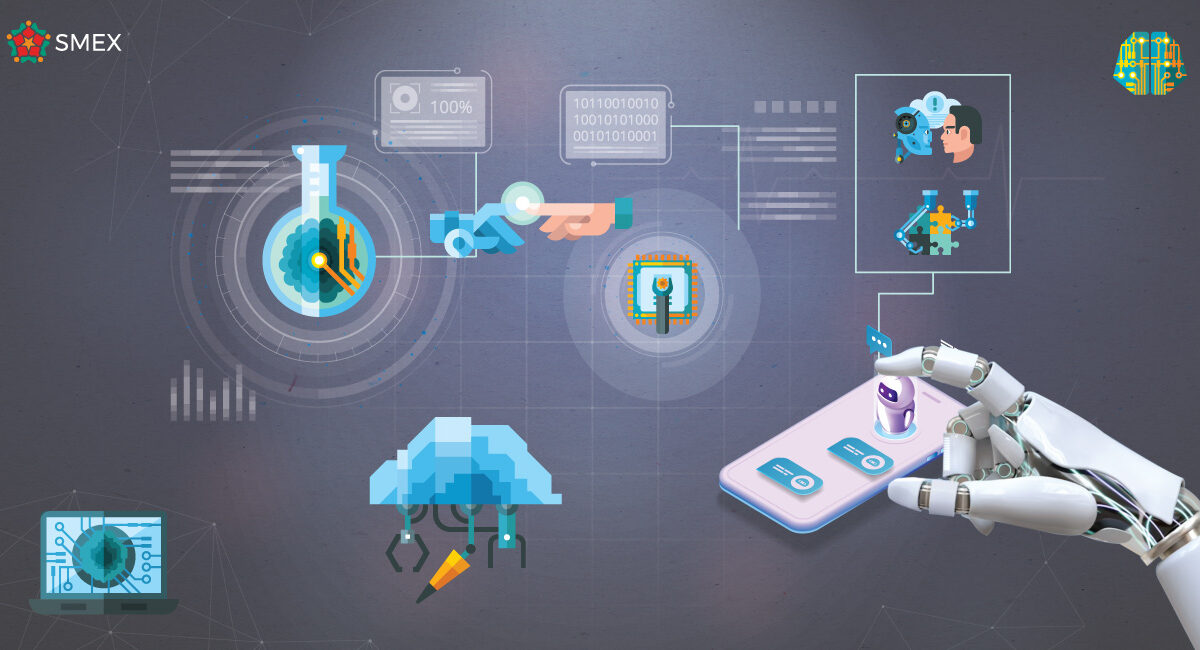Perhaps our first impulse when we hear “artificial intelligence” (AI) is to imagine an army of robots preparing to invade the world and erase humanity. But AI, like any other technology, can be used to support those who need it or cause harm. In other words, artificial intelligence is merely a tool that obeys users’ wishes. Indeed, AI has been an integral part of many of the systems we depend on in our daily lives.
A range of different technologies falls under the umbrella of AI. Each has its strengths and weaknesses and operates similarly to machines and digital computers that carry out tasks that simulate human capabilities to some extent, such as thinking or learning from past experiences. AI, however, can do more advanced operations that require a certain degree of so-called “intelligence.” It interprets an immeasurable amount of data and builds causal associations that result in a decision within an iterative process. This renders AI capable of more than just capturing and storing data. A camera, for example, can take a picture, but without artificial intelligence add-ons, it cannot identify who is in it.
“Moravec’s Paradox” can help us understand the state of artificial intelligence. The paradox considers that “things that are easy for machines are difficult for people, and vice versa.” In other words, it is easy to train computers to complete tasks that seem hard for humans, like math and logic, but it is also hard to train them to do things humans don’t even think twice while doing, like walking, feeling, and analyzing emotions.
Fields of Artificial Intelligence
Based on the above, we can distinguish between two fields of AI:
- Simple/Narrow Artificial Intelligence: This is the field we use the most in our daily lives. Computers are trained to perform specific tasks under human supervision. The percentage of supervision and control required depends on how developed the used technology is. The best examples of this are Apple’s Siri, Amazon’s Alexa, IBM’s Watson, facial recognition software, translation tools, and chatbots.
- Complex Artificial General Intelligence (AGI): To this day, this field remains a “dream”; a theoretical description of artificial intelligence, in which machines and technologies possess human intelligence, self-awareness, and the ability to solve problems, learn, and plan for the future. Technologies in this field may surpass our human intelligence. However, all this remains theoretical in the absence of any such models.
“Knowledge” plays a fundamental role in the strength and consistency of AI technologies. It dictates how AI can interact and repeat operations within the limits of the knowledge available to its algorithms. As with humans, these technologies need relevant external information and data to form a point of view and execute orders accordingly, which means that all types of AI depend mainly on collected knowledge.
Machine learning technology is trained on representational data to build specific solutions. The quality of the results improves over time with iterative experiments and more data-feeding, which makes solutions and results sensitive to the type, availability, and quality of data and changes that occur to it in the real world.
Artificial Intelligence Applications
Whether we realize it or not, we are surrounded by AI in every aspect of our daily life. What we see on the screen in front of us every time we browse the news on our Facebook feed, perform a web search, get a product recommendation from Amazon, or book a flight online, is generated by AI technologies.
We also find AI systems in fields we may not be in direct contact with their application of AI but which are essential to our life, including:
- Healthcare: AI is used in healthcare to improve the accuracy and speed of diagnosis. For example, AI systems can analyze medical images to detect early signs of diseases like cancer and help doctors develop customized treatment plans based on a patient’s medical history and private data.
- Financial Transactions: AI is used to detect fraud, predict market trends, and manage risks. For example, banks use AI systems to detect suspicious transactions and analyze large amounts of data to identify patterns that may indicate fraud in the stock market, obtain advice, analyze the history and performance of the stock, and evaluate the factors that affect it., which made the markets witness interest from less wealthy investors all over the world.
- Manufacturing: AI technologies are used in manufacturing to improve efficiency and productivity. AI systems can analyze data from sensors on factory equipment and machinery to predict when maintenance will be needed and reduce downtime, reflecting increased productivity.
- Marketing and Advertising: AI is used in direct retail to personalize customers’ shopping experiences. Online retailers use recommendation algorithms to suggest products that might interest customers based on their browsing and purchasing history.
- Transportation: AI plays an important role in improving safety and efficiency in transportation. Self-driving cars use artificial intelligence to detect and respond to changes in road conditions and make decisions about navigation and traffic.
These are just some examples of AI’s integration into our daily lives. As this technology continues to evolve, we expect to see more of its applications in the near future. Undoubtedly, AI plays a fundamental, game-changing role in addressing pressing societal challenges and might contribute to creating a better and somewhat easier future. Perhaps the data of the Middle East region offers a golden opportunity to witness the radical outcomes of AI. The early adoption of artificial intelligence tools in areas such as agriculture, health, and education can lead to better management of available resources, raising workforce capacities, and achieving social, environmental, and economic benefits.
Improved Productivity
In a related context, the changes resulting from the use of artificial intelligence in our societies have economic, legal, political, and regulatory effects in the longer term; some are positive and laudable, while others are unfavorable.
Contrary to what most people believe, AI can be put to good use for the service of humanity. Artificial intelligence could lead to a qualitative development in the nature of the labor force that the market needs. The talk about machines inevitably taking over jobs creates fear among workers, but the latest studies are reassuring in this regard. In a report on the future of employment, the World Economic Forum estimated that AI will replace around 85 million jobs by 2025; however, the report concluded that AI would create about 97 million new jobs in the same timeframe.
The real challenge, then, lies in the capacity of humans to redirect their passion to new jobs requiring the development of their capabilities, combining technical and soft skills, which machines cannot learn or acquire.
AI technologies and systems taking over routine or dangerous tasks would significantly improve workplace efficiency and allow humans to be creative. Indeed, it grants the human workforce the freedom to undertake tasks involving creativity and emotional intelligence.
Artificial intelligence will positively and noticeably impact the healthcare sector thanks to the development of monitoring and diagnostic capabilities. It could improve the processes of managing healthcare and medical institutions, reducing operational costs, improving the possibility of implementing personal treatment plans for patients, facilitating drug insurance protocols, and granting healthcare providers better access to patient information to assist in their care efficiently.
Societies will gain additional hours of productivity once autonomous transportation is introduced through AI technologies, reducing traffic congestion problems while improving work productivity.
In another context, using AI technologies improves the means to monitor criminal activity and solve crimes with less time and effort. It also contributes to creating many essential opportunities in the field of justice and law to define codes covering the effective use of technology without infringing on individual privacy.
As technology grows more complex, moral and societal issues become more challenging to address, revealing its darker sides. The central dilemma lies in the fact that the technical development of AI is so fast that cultural theories and philosophical and ethical debates around it cannot keep up.
One of the most critical challenges artificial intelligence systems face is the results emerging from fragmented and biased data. We have already observed how many technologies and software inherit and reproduce racist and sexist biases prevalent in society.
Other challenges revolve around violating the privacy of individuals and exploiting their data for undisclosed purposes, the latest of which was the “Lensa” application. Artificial intelligence software made it easier to collect private data (such as age, location, preferences, facial traits, etc.) for tracking companies to collect and analyze. Their manufacturing companies then employ them to personalize users’ experiences online, or sell them to third-party entities without the knowledge or consent of their owners, thus endangering their privacy.
A prominent example is the famous incident at “DeepMind” and its dealings with a company affiliated with the British National Health Service (NHS) to purchase a database of sensitive information of more than 1.6 million people. This shows that the cost of some technologies does not lie in the sum paid for them but in the size and the degree of sensitivity of the data collected.
The autonomy of artificial intelligence remains one of the most severe challenges facing the integration of AI technologies into our daily lives, as the dilemma of algorithms making ethical decisions still exists. If a self-driving car cannot avoid killing one of two pedestrians, how does the car’s control software choose its victim? What criteria does it rely on?
Moreover, we are witnessing a monopoly of the use of these technologies. As artificial intelligence takes its first steps in countries of the Global Majority, a handful of countries in the Global North have been investing billions of dollars in research, depriving the former of active participation in defining the codes for these technologies. The uncontrolled influence of these technologies could lead to global disruptions not confined to their countries of origin.
Legal Aspect
Using artificial intelligence without enacting regulatory laws and legislation is one of the most fundamental obstacles that make artificial intelligence an existential threat to humanity. One serious challenge for AI workers is the proliferating arms race for military equipment and devices possessing self-operating artificial intelligence technologies. One example is the Israeli suicidal drone Harpy which can make a direct killing decision during combat without any human intervention.
There have been timid attempts to address this issue, the most recent of which was the “REAIM” summit, held in the presence of more than 80 government representatives, to sign a global regulatory statement as a preliminary draft to support the responsible use of artificial intelligence technologies in the military field.
Despite these attempts to set legislations and regulations that limit the risks of artificial intelligence to humans, there is still a long way to reach safe AI that benefits humanity and protects marginalized groups most vulnerable to the dangers of its unethical use.
The most significant challenge for the coming period lies in balancing between protecting the fundamental rights of users, enhancing their ability to understand AI technologies, and controlling the use of AI-based systems by adopting targeted and specific codes of ethics, in addition to finding ways to confront parties that monopolize the benefits of AI technologies.



